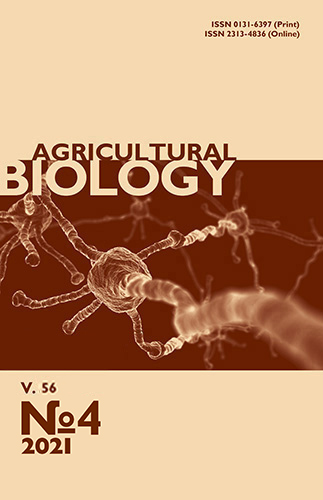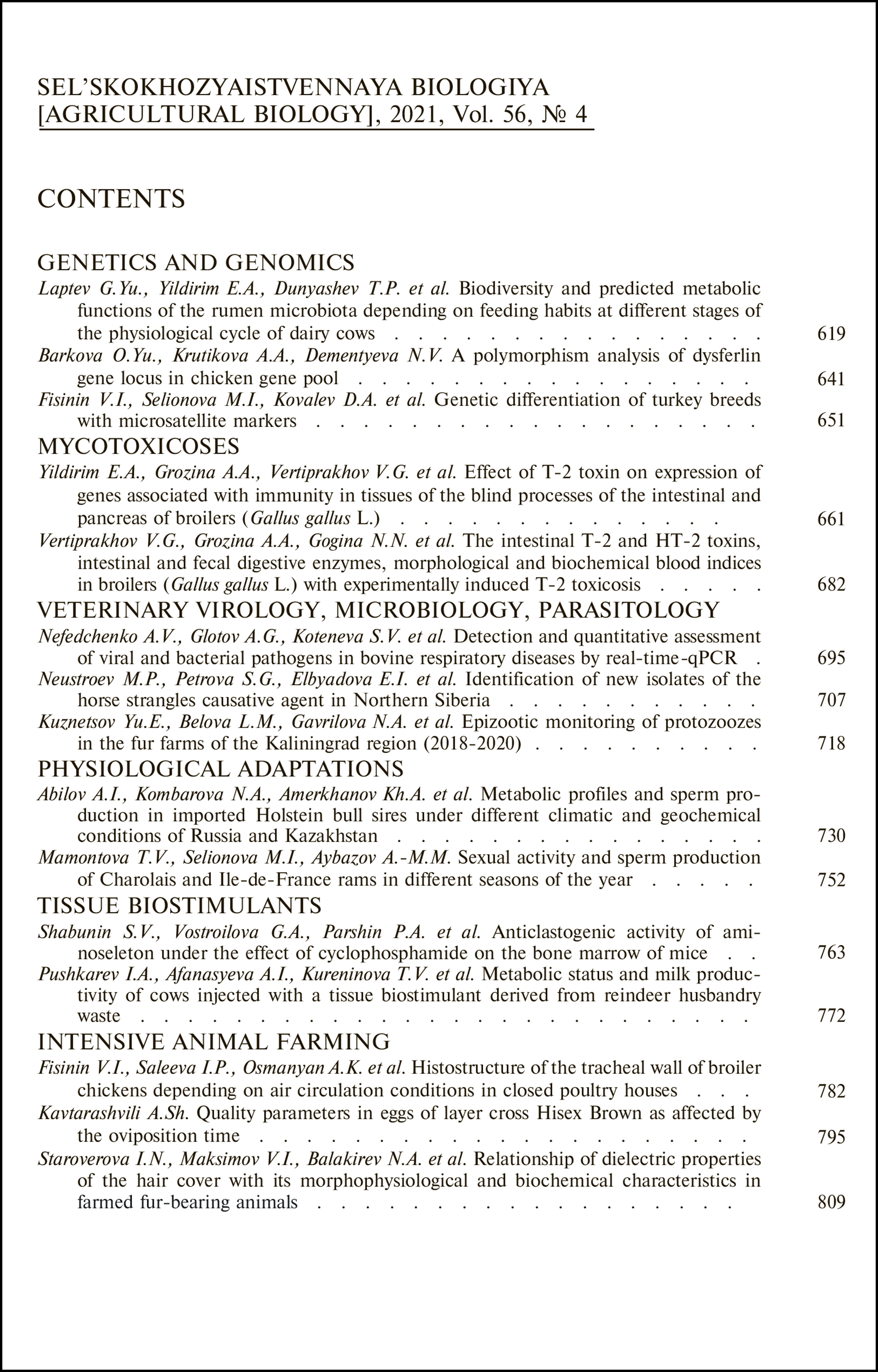doi: 10.15389/agrobiology.2021.4.707eng
UDC: 636.11/.15:619:579.62:577.2
IDENTIFICATION OF NEW ISOLATES OF THE HORSE STRANGLES CAUSATIVE AGENT IN NORTHERN SIBERIA
M.P. Neustroev1 ✉, S.G. Petrova1, E.I. Elbyadova1, N.P. Tarabukina1,
V.A. Alekseev2, A.A. Popov1
1Safronov Yakut Research Institute of Agriculture, FRC Yakut Research Center SB RAS, 23/1, ul. Bestuzheva-Marlinskogo, Yakutsk, Republic of Sakha (Yakutia), 677001 Russia, e-mail mneyc@mail.ru (✉ corresponding author), sargy1970p@mail.ru, elbyadova@bk.ru, hotubact@mail.ru, andrian.popov.94@bk.ru;
2GAUTechnopark Yakutia, 1, ul. Truda, Yakutsk, Republic of Sakha (Yakutia), 677001 Russia, e-mail info.excellbio@gmail.com
ORCID:
Neustroev M.P. orcid.org/0000-0003-0672-4109
Tarabukina N.P. orcid.org/0000-0002-5493-8809
Petrova S.G. orcid.org/0000-0002-9544-9235
Alekseev V.A. orcid.org/0000-0001-6751-6210
Elbyadova E.I. orcid.org/0000-0001-7018-7411
Popov A.A. orcid.org/0000-0002-6599-8401
Received February 12, 2021
Infectious and invasive diseases cause significant damage to the economy and decrease the productivity of horse herd farming. Equine strangles (Streptococcus equi) is the most economically damaging. Specific prevention of the disease widespread in Asia, Russia and CIS poses a serious problem. In this work, for the first time in the Far North, we isolated and identified three new Streptococcus equi strains prospective for the diagnostics and development of strangles vaccines. The study aimed to culture, identify morphologically, culturally, biochemically, and genotypically new isolates of the equine strangles causative agent for the development of vaccines. A survey of 6-10-month old Yakut and Kazakh foals (Equus ferus caballus) was performed in the Republic of Sakha (Yakutia) regions (the farms in Namskiy, Khangalasskiy, Amginskiy, Megino-Kangalarskiy districts and in Yakutsk) and in Kazakhstan in 2015-2017. In total, 63 collected biospecimens included 45 nasal discharges (27 from diseased and 18 from healthy foals), 7 submandibular lymph node abscesses, and 11 parenchymal organs. The infectious agents were isolated and identified by 16S rDNA genotyping using PCR and based on biochemical traits. Morphological and cultural properties were studied using meat peptone broth (MPB) added with 1 % glucose and 10 % horse blood serum and on meat peptone agar (MPA) with 1 % glucose and 10 % horse blood serum or 5 % defibrinated horse blood. Pus swabs and preparations of liquid and agar cultures stained by the Gram procedure were investigated with a light microscope. Biochemical properties were studied by plating on MPA with 40 % bile, 6.5% saline MPA, agar with sodium azide, and Giss’s medium with glucose, lactose, mannitol, maltose, sucrose, sorbitol, and dulcite. The isolates were biochemically assigned to species using API 20 Step strips (an API test system, bioMerieux, France). The virulence of the isolates (LD50) was assessed on white mice challenged subcutaneously with 0.2-0.5 cm3 of 1-day suspensions (1×103 to 1×109 CFU per mouse). Genotyping was performed with specific primers Seel-F 5ʹ-CGGATACGGTGAT-GTTAAAGA-3ʹ and Seel-R 5ʹ-TTCCTTCCTCAAAGCCAGA-3ʹ. The Streptococcus equi 16S rRNA gene was sequenced for six isolates of strangles streptococcus, of which three we suggest for the development of strangles vaccines. Polymerase chain reaction with specific primers serves as the most reliable and fastest method for identifying strangles streptococcus. Based on genotyping data and the cultural, morphological and biochemical properties, the Streptococcus equi H-5/1 isolate belongs to the Streptococcaceae family, Streptococcus genus, Streptococcusequi ssp. equi and corresponds to the typical characteristics of the species. The nucleotide sequence of the 16S rRNA gene fragment of the isolate H-5/1 after sequencing was deposited in the NCBI GenBank database (MW486609). The Streptococcus equi H-5/1 strain was deposited in the All-Russian State Collection of Microorganism Strains Used in Veterinary Medicine and Animal Husbandry (VGNKI, registration number VKSHM-B-141P, certificate of deposit dated May 22, 2018), and patent for invention No. 2703485 (“A strain of bacteria Streptococcus equi used for the production a vaccine against strangles”) dated 10/17/2019 was received. The new Streptococcus equi strains we described here hold promise in the developing strangles vaccines. Note, Enterococcus faecales, Streptococcus piogenes, toxigenic and mold fungi Aspergillus and Mucor genera were also isolated from foals with clinical sings of equine strangles. Our findings attract attention to these microorganisms possibly involved in the development of equine strangles in young horses, which should be accounted in diagnostics of this pathology.
Keywords: equine strangles, streptococcus, Streptococcus equi, biochemical traits, genotyping, Yakut horses, Kazakh horses, Siberia, the Far North, bacterial infections.
REFERENCES
- Timoney J.F. The pathogenic equine streptococci. Vet. Res.,2004, 35(4): 397-409 CrossRef.
- Sweeney C.R., Timoney J.F., Newton J.R., Hines M.T. Streptococcus equi infections in horses: guidelines for treatment, control and prevention of strangles. Journal of Veterinary Internal Medicine, 2005, 19(1): 123-134 CrossRef
- Harris S.R., Robinson C., Steward K.F., Webb K.S., Paillot R., Parkhill J., Holden M.T.G., Waller A.S. Genome specialization and decay of the strangles pathogen, Streptococcus equi, is driven by persistent infection. Genome Research, 2015, 25(9): 1360-1371 CrossRef
- Gustokashin K.A. Vestnik Altaiskogo gosudarstvennogo agrarnogo universiteta, 2013, 11(109): 79-80 (in Russ.).
- Bayanzhargal B., Badmaeva O.B., Rinchinova O.N., Tsydypov V.Ts. Veterinariya Kubani, 2014, 1: 10-12 (in Russ.).
- Neustroev M.P. Myt loshadei v Yakutii (etiologiya, epizootologiya, mery bor'by i profilaktika) [Equine strangles in Yakutia (etiology, epizootology, control measures, and prevention)]. Novosibirsk, 2000 (in Russ.).
- Bizhanov A.B., Sansyzbai A.R., Namet A.M., Baidarov A.Kh. Zharshy, 1997, 6: 13-18 (in Russ.).
- Boyle A.G., Timoney J.F., Newton J.R., Hines M.T., Waller A.S., Buchanan B.R. Streptococcus equi infections in horses: guidelines for treatment, control, and prevention of strangles—revised consensus statement. Journal of Veterinary Internal Medicine, 2018, 32(2): 633-647 CrossRef
- Dzhetigenov E.A., Bektashev A.B., Aitbaev A.A. Vestnik Kyrgyzskogo natsional'nogo agrarnogo universiteta im. K.I. Skryabina,2016, 2(37): 190-194 (in Russ.).
- Khartford O.M.(IE), Foster T.D. (IE), Yakobs A.A.K. (NL). Shtamm i kul'tura shtamma Streptococcus equi TW 928 dlya vaktsinatsii loshadei. A.c. RU 2194752 C2 MPK 7 A 61 K 39/09. Zayavl. 24.01.97. Opubl. 30.12.02 [Strain and culture of Streptococcus equi TW 928 for vaccination of horses. A.c. RU 2194752 C2 MPK 7 A 61 K 39/09. Publ. 24.01.97. Bull. 30.12.02] (in Russ.).
- Nearmat-Allah A.N.F., Damaty H.M. Strangles in Arabian horses in Egypt: clinical, epidemiological, hematological, and biochemical aspects. Veterinary World,2016, 9(8): 820-826 CrossRef
- Berezhnaya L. Veterinariya sel'skokhozyaistvennykh zhivotnykh,2008, 8: 20-27 (in Russ.).
- Kim J.W., Jung J.Y., Lee K., Lee H., Kim H.Y., Yoon S.S., So B.J., Choi E. A case of Streptococcus equi subspecies zooepidemicus infection in a thoroughbred horse. Journal of Comparative Pathology,2018, 158: 137 CrossRef
- Libardoni F., Machado G., Gressler L.T., Kowalski A.P., Diehl G.H., dos Santos L.C., Corbellini L.G., de Vargas A.C. Prevalence of Streptococcus equi subsp. equi in horse and associated risk factors in the State of Rio Grande do Sul, Brazil. Research in Veterinary Science,2016, 104: 53-57 CrossRef
- Webb K., Barker C., Harrison T., Heather Z., Steward K.F., Robinson C., Newton J.R., Waller A.S. Detection of Streptococcus equi using a triplex qPCR assay. Veterinary Journal, 2013, 195(3): 300-304 CrossRef
- Cordoni G., Williams A., Duram A., Florio D., Zanoni R.G., Ragione R.L. Rapid diagnosis of strangles (Streptococcus equi subspecies equi) using PCR. Research in Veterinary Science, 2015, 102: 162-166 CrossRef
- Boyle A.G., Stefanovski D., Rankin S.C. Comparison of nasofaryngeal and guttural pouch specimens to determine the optimal sampling site to detect Streptococcus equi subsp. equi carriers by DNA amplification. BMC Veterinary Research, 2017, 13: 75 CrossRef
- Boyle A.G., Rankin S.C., Duffee L., Boston R.C., Wheeler-Aceto H. Streptococcus equi detection polimerase chain reaction assay for equine nasopharyngeal and guttural pouch wash samples. Journal of Veterinary Internal Medicine, 2016, 30(1): 276-281 CrossRef
- Cvetojević D., Radanović O., Milićević V., Jezdimirović N., Kureljušić B. Polyarthritis in goat-kids caused by streptococcus equi subspecies zooepidemicus. Acta Veterinaria-Beogra, 2017, 67(3): 432-440 CrossRef
- Khoult D.G., Krig N., Smit P., Steili Dzh., Uill'yams S. Opredelitel' bakterii Berdzhi. Tom 2 [Bergey's keys to bacteria. Volume 2]. Moscow, 1997 (in Russ.).
- Metodicheskie ukazaniya po laboratornoi diagnostike myta [Methodical instructions for laboratory diagnostics of strangles]. Moscow, 2007 (in Russ.).
- Shevchenko A.A., Chernykh O.Yu., Shevchenko L.V., Dzhailidi G.A., Zerkalev D.Yu., Litvinova A.R., Dvadnenko O.V. Diagnostika stafilokokkozov i streptokokkozov [Diagnosis of staphylococcosis and streptococcosis]. Krasnodar, 2013 (in Russ.).
- Ashmarin I.P., Vorob'ev A.A. Statisticheskie metody v mikrobiologicheskikh issledovaniyakh [Statistical methods in microbiological research]. Leningrad, 1962 (in Russ.).
- Wilson K. Preparation of genomic DNA from bacteria. Current Protocols in Molecular Biology,2001, 56(1): 241-245 CrossRef
- Zhirkov A.D., Tatarinova S.S., Tarabukina N.P., Neustroev M.P. Agrarnyi vestnik Urala, 2013, 7(113): 20-21 (in Russ.).
- Neustroev M.P., Tarabukina N.P., Petrova S.G., El'byadova E.I. Trudy VIEV, 2018, 80(1): 268-272 CrossRef (in Russ.).
- Dauvillier J., Woort F., Erck-Westergren E. Fungi in respiratory samples of horses with inflammatory airway disease. Journal of Veterinary Internal Medicine, 2018, 33(2): 968-975 CrossRef
- Pelkonen S., Lindahl S.B., Suomala P., Karhukorpi J., Vuorinen S., Koivula I., Väisänen T., Pentikäinen J., Autio T., Tuuminen T. Transmission of Streptococcus equisubspecies zooepidemicus infection from horses to humans. Emerging Infectious Diseases,2013, 19(7): 1041-1048 CrossRef
- Laing G., Christley R., Stringer A., Aklilu N., Ashine T., Newton R., Radford A., Pinchbeck G. Respiratory disease and sero-epidemiology of respiratory pathogens in the working horses of Ethiopia. Equine Veterinary Journal, 2018, 50(6): 793-799 CrossRef
- Smith F.L., Watson J.L., Spier S.J., Kilcoyne I., Mapes S., Sonder C., Pusterla N. Frequency of shedding of respiratory pathogens in horses recently imported to the United States. Journal of Veterinary Internal Medicine,2018, 32(4): 1436-1441 CrossRef
- North S.E., Wakeley P.R., Mayo N., Mayers J., Sawyer J. Development of a real-time PCR to detect Streptococcus equi subspecies equi. Equine Veterinary Journal,2013, 46(1) CrossRef












